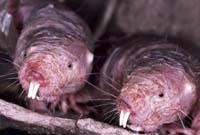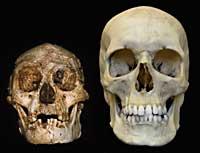Whims of nature
2008/06/01 Lakar Iraizoz, Oihane - Elhuyar Zientzia Iturria: Elhuyar aldizkaria
Estremófilos Estremófilos
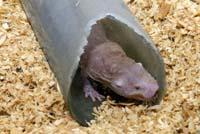
We, human beings, have called them this way because the conditions in which these living beings live are unsustainable for us. For them they are essential, since they are characteristics of their natural habitat. If we left these 'hard' conditions and placed them in a more 'warm' environment they would die.
When we say that a place has extreme conditions we can refer to a series of features. From our point of view, a place can be uninhabitable for being too cold or hot, for receiving too many radiations, for having excessive pressure (deep waters of the oceans, for example), for having a little water, for being excessively salted, for having an oxygen deficit, for being too acidic or too basic, etc.
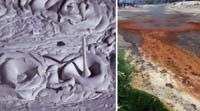
Well, in the places where all the above mentioned conditions are given, there are living beings. In fact, most are unicellular (both prokaryotes and eukaryotes). For example, if it is a bacterium that lives at 114 °C, above the boiling temperature of the water ( Pyrolobus fumarii ), as well as one that survives three thousand times the radiation that would kill a person ( Deinococcus radiodurans ).
Although to a lesser extent, there are also pluricellular living beings among the estremophils. A curious example is the African mole (Heterocephalus glaber). This mammal lives buried in galleries and large groups. This creates a very particular environment around it. For example, the concentration of carbon dioxide in the colonies of these octopus rats is very high, which makes the atmosphere very acidic. We would put ourselves in that atmosphere. Their skin, however, does not react with acids and do not feel the anger that we would feel.
Living fossils Living fossils
The species evolve; when the conditions of the medium change, those that better adapt to the new conditions advance. However, some species have changed very little since a certain time. In colloquial language they are called living fossils, since their fossils possess the same or very similar characteristics.
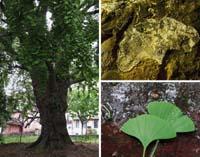
As the current ginkas are very similar to those that lasted. Like them, they have primitive characteristics. For example, they are dioecious, that is, male sex organs and females are formed in different units, and male gametes (pollen seeds, we would say) are flagellate, that is, mobile.
Among the animals there are eleven species classified as living fossils, including celacanto. It is a fish that was formed in the devonic era, about 400 million years ago, which in the Carboniferous grew a lot (it is most of the fossil remains) and for a long time they believed that it had disappeared in the Cretaceous. However, in 1938 a Celacanthus was captured alive in South Africa. It was not of the same species as in earlier times, but it was very similar.
Change in islands
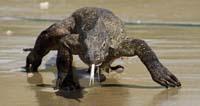
Many of the animals that inhabit the islands have a very different size to those of their continents. In fact, size is a characteristic that varies very easily depending, among other things, on the pressure of predators and the availability of resources. It can be said that the islands are isolated areas, so there are very few large predators for which it is very difficult to get there. On many occasions they are relatively small, that is, the resources, both vegetable and animal, are limited.
Sometimes animals grow when they reach an island. A known example is the Komodo dragon. In a few islands of Indonesia lives the largest known lizard. It has a length of more than three meters and a weight of between 80 and 140 kilos.
It seems that four million years ago he separated from his Australian leader when he arrived on the islands of Indonesia. There he had no rivals to dismantle the territory nor had to flee from predators. Yes, however, enough foods. Therefore, it increased and increased to its current size.
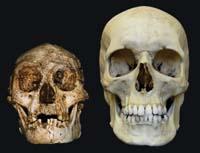
In the islands the opposite phenomenon is also observed: insular nanism. It usually occurs in large continental sized animals. When they arrive on an island they have less food available. In this situation, if the body size is reduced, fewer foods would be needed to feed properly.
There have been several cases in which dwarf relatives of animals living on the continents have been found: elephants, hippos, goats, buffalos... and also humans. In 2004, the remains of 18,000 year-old human ancestors, barely one meter in length, were discovered on East Asian Flowers Island. He was called Homo floresiensis, for being a human species that suffered insular nanism. However, there is a great debate about this, and they have not yet clarified whether the remains found belong to a human species that suffered nanism or modern beings that presented some malformation.
Yesteryear, prosperous now
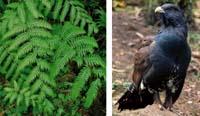
The Earth is constantly changing from the Earth. We know it has had colder times than the current and hottest. We also know that the current distribution of the continents is due to plate tectonics, but until the current situation has changed its location a lot. The Basque Country, for example, has flooded most of its geological history: about 300 million years ago came the first plots of water and 40 million years ago or they did it definitively. At the outcrop, there were times of tropical climate, others of glacial covering, etc.
As the conditions of the environment change, the distribution of living beings has been evolving. The majority of living beings who at one time were abundant in a given place disappeared by changing the conditions, imposing those who were better adapted to the new conditions.
However, some living beings renounced this general trend, that is, they sought places suitable for life and remained as representatives of the living beings that in their day dominated. They are relyctic species. For example, the fern of Woodwardia radicans lives in Macaronesia (Canary Islands, Madeira Islands, etc. ), that is, in a tropical tropical subtropical climate. However, in the Basque Country (in general, on the entire Atlantic slope) there are populations of this species on the margins of some shaded and protected streams. This suggests that at one time the distribution of the species was wider and has been maintained since then in humid areas that do not freeze in winter.
If a certain population of a species is not confused with individuals of other populations, it is very likely that over time it will become another. The genetic changes are accumulating in this population, increasingly unequal with respect to the original. Logically, the new species emerging from this population will have a very limited distribution.
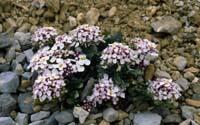

Gai honi buruzko eduki gehiago
Elhuyarrek garatutako teknologia





